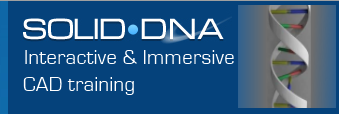A CAD smackdown – direct vs. parametric modeling
Yesterday’s CADalyst CAD magazine, host a webcast about “Direct vs. Parametric”.
Topic: When, why and how to use direct and/or parametric modeling in your business.include
A CAD smackdown — direct vs. parametric
On the Edge, the Solid Edge mechanical chronic of Cadalyst CAD site since 2003, propose a webcast Direct vs. Parametric Thurday February 24 2011
Pattern traditional and Synchronous
In a recent discussion in a newsgroup, question was ask about hole alignment. Portion of the discussion where about placing hole in a circular pattern. So I produce a small video, this not answer all questions but give an idea of the concept.
The initial idea was to show a little bit more about Pattern. However, I realize interesting facts.
1- Word was spread that 2D cannot control 3D. So people reading about Synchronous where leaving with this impression. I confess I am part of this miss leading information. Especially where the 2D is move in the used Sketches bin, when we show extrusions. However, for pattern this is not applied.
2- I use more often pattern along a curve in ST.
Why?
Because the concept of procedural feature. Procedural feature inside Solid Edge is like an evolution of what we commonly call feature. Common procedural features are hole, shell and round. You can easily identified procedural feature, when select a small handle is available. By trying to reproduce this concept inside each of my actions, it seems easier to control a Synchronous model.
3-The build time of this simple part was roughly 30 percent less. 1:30 versus 1:00.
This is not the most rigorous scientific test ever, but I believe enough accurate to see the potential.
4- Users have the same controls and more flexibility when it comes time to apply changes on the part versus a traditional part, even if less constraint.
5- Has you see, this is done while evolving inside Fluent Interface….
Not bad for a first release. What could we expect in the next coming releases?
If you take time to read on the net those who blog about ST you can find interesting clue
«….Workflow — Here, I think the whole story wasn’t quite made clear. Yes, it’s true that history-based modeling and Synchronous Technology are quite different and you don’t mix and match the modeling styles within the same part design. But we DO allow and encourage mix/match at the assembly level – you can create models using either technology (both are included in Solid Edge even in the base package) and create assemblies of both types mixed. With the next release of Solid Edge, ST2, we will continue to expand this notion, allowing even more flexibility with assemblies with mixed part types. In general, you will continue to see us evolve and merge the two technologies to continue to leverage the best of each….»
«…Just in the modeling arena, they differ quite a bit in how they handle features (procedural features – a lot more on this coming in ST2) and dimension driven editing…»
Click HD on the video to watch in hi-def


